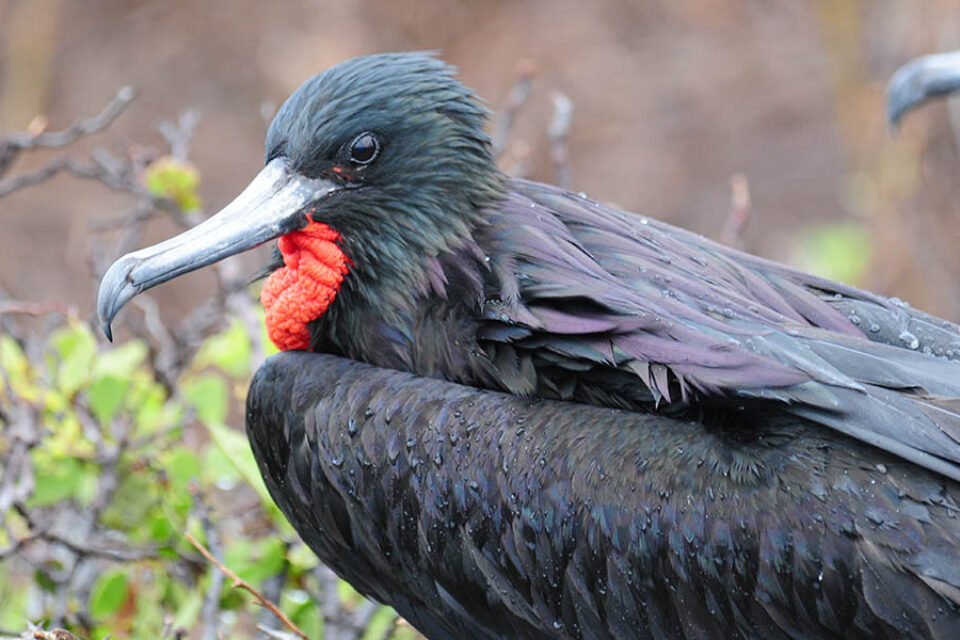The Galapagos National Park has published the results of a study undertaken by a talented international team of researchers to study the endemic great frigatebird of Galapagos (Fregata minor).
Former Communications & Membership Assistant at Galapagos Conservation Trust

The researchers objective was to gain a deeper understanding of the behaviour of the endemic Great frigate bird, especially the sleeping patterns and how sleep effects their day to day survival. The scientists chose to study Fregata minor due to the bird’s ability to fly over the ocean looking for food for weeks at a time. The notion of a prolonged flight is interesting, as the bird cannot land, or conventionally sleep for that matter. There is already existing evidence that birds sleep mid-flight, as cited by the researchers; ‘It is commonly assumed that flying birds maintain environmental awareness and aerodynamic control by sleeping with only one eye closed and one cerebral hemisphere at a time. However, sleep has now been demonstrated in flying birds.’
This new research undertaken by the team has examined this claim more closely. The study was led by Niels Rattenborg of Max Planck Institute, Germany alongside Sebastian Cruz, a Galapagos based ornithologist. The objective the team attempted to determine was how long Great frigate birds sleep for each day, as well as understanding how the birds are able to function with so little sleep, while some people and animals suffer quite dramatically when lacking sleep.
Tracking

The fieldwork was carried out on Genovesa Island, also known as ‘Bird Island’ situated towards the north east of the Archipelago. The research was collected over a period of a number of weeks using a small device (Electroencephalogram) which measuring EEG changes, imperative to measure the birds behaviour. The device was developed by Alexei Vyssotski of Zurich University and the Swiss Federal Technology Institute, and is one of the most advanced ways to track bird movements and activities ever created.
This device was placed on several individuals e nesting across Genovesa along with a GPS tag. Luckily, Great frigate birds nest close to the ground, usually in the branches of mangroves and scrubby bushes. They have little to no fear of humans, therefore both the younger chicks and older birds are very easy to approach and almost no stress is experienced by the bird when researchers apply and remove the tags. The tags were placed on to the bird’s backs, and the researchers made sure that the device would not alter any physical element of the bird while they were on. The tags were then removed as soon as all necessary data had been collected.
The research team reported the results brought a surprising discovery. It was found that on average, Great frigate birds sleep for less than an hour per day while on foraging trips. When they returned to their nests, they would sleep for up to 12 hours per day.

© Trevor Platt
Results
An analysis of the data found that Great frigate birds spend the majority of the day awake. Both magnificent frigate birds and great frigate birds are capable of flying nonstop for 10 days at a time. They have also been known to travel distances of up to 3000km.

The research showed that great Frigate birds do in fact sleep, most commonly, during the evening. Slow-wave sleep patterns were registered for around one hour a day. This means the birds sleep while in flight. But how do they sleep while flying? Frigate birds have the ability to control their cerebral hemispheres, alternating sides to awake and asleep throughout the entire day, just like most cetaceans and sharks. The research showed that frigate birds sleep by shutting down one hemisphere of the brain, while the other hemisphere remains connected to their eyes in order to stays alert and to avoid collisions. The research also shows that frigate birds, surprisingly, experience REM sleep for a couple of seconds at a time while in flight. This deeper sleep leads to loss of muscle control, resulting in the Frigate birds silently falling for a number of seconds at a time. These episodes are daunting and could be scary for the birds as they jolt awake while plunging towards the sea, however, these moments of free fall do not affect their flight patterns.
For Rattenborg and Cruz, it was a surprise to discover that this could occur in either one hemisphere, or even both hemispheres simultaneously. This research proves that the great frigate bird can sustain prolonged flights by obtaining normal amounts of sleep on the wing, as well as reaching REM sleep.
Related articles

Wildlife facts